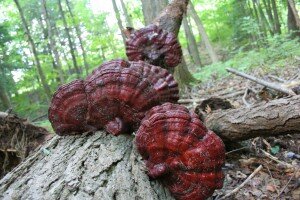The Restorative Reishi
The white growing tip of these younger reishi means that they are still actively maturing.
Something subversive is brewing in the dimly lit depths of my pantry. Two mason jars sit atop a nondescript white shelf, stuffed with thinly sliced reishi mushrooms steeping in cheap vodka.
Sounds innocent enough, right? Yes, my reishi moonshine is entirely safe and legal, but something tells me that Big Pharma would be less than thrilled about my wildcrafted mushroom tincture concoction. While I certainly see a place for Western pharmaceuticals – they saved my mother’s life three times – there is something empowering and paradigm shifting about finding medicine in the woods instead of at the drugstore.
Many popular pharmaceuticals have active ingredients isolated from plants or fungi or synthetic analogs of these chemicals, but we forget about the natural sources of our medicines when we encounter them as brightly colored pills encased in plastic. It’s no surprise we now take aspirin instead of willow bark tea – turning a plant into a pill makes it easier for a pharmaceutical company to regulate, patent and market a drug.
There is nothing inherently wrong with this, but I am weary of the way it makes us overlook the inextricable connection between human health and ecological health. Perhaps if we were more accustomed to foraging for medicine in the forest, we would think twice before chopping down rainforests that could hold cures to our most menacing diseases, not to mention mitigating our most noxious assault on planetary health - global warming. Any assault on planetary health is ultimately an assault on our own health, but it is easy to overlook this when we cling to the myopic and antiquated notion that technology and medicine will extricate us from whatever environmental quandaries we may face.
Don’t be fooled by the boxes of Annie’s Mac & Cheese – something subversive is brewing in my pantry . . .
Finding a wild reishi mushroom - be it the varnished red Ganoderma tsugae on hemlock in the Northeast and Southwest; the varnished yellow-ocher G. curtisii in southern New England and throughout the central and southeastern states; or the varnished red G. lucidum in southern New England and stretching across the seas into Europe and Asia – can be quite a magical experience. Even though I find reishi regularly in hemlock forests around Ithaca from May through July, I still am mesmerized every time I see a tree covered in them, in all their glossy glory. Reishi are hard to mistake for any other conk mushroom, with their gradient of lacquered red, orange, yellow, and white hues. As a rule, if the conk you are holding is breathtakingly beautiful, you have found a reishi.
Emerging reishi mushrooms make a delicious and medicinal appetizer when lightly sauteed. Because reishi has an indeterminate growth habit, most specimens will grow back after being cut. Nonetheless, I harvest babies sparingly.
As if its looks were not enough, reishi is reputed to have analgesic, anti-allergic, anti-inflammatory, antibacterial, antioxidant, antitumor, antiviral, anti-HIV, and blood pressure reducing effects. Before reishi cultivation became widespread, in China it was a rare wild mushroom reserved for royalty and their ilk. The Chinese names for reishi – Mushroom of Immortality, Ten-Thousand Year Mushroom, and Herb of Spiritual Potency – reflect its status as a panacea.
Reishi belongs to a class of herbal medicines called adaptogens, a group which includes ginseng, the only other natural medicine traditionally revered quite as highly by the Chinese. Adaptogens are reputed to enhance the body’s overall ability to cope with physical and mental stress. Reishi can be taken acutely when you feel the onset of a cold, but the system strengthening effects may not fully set in until several weeks of daily use in small doses.
Reishi tincture is expensive, and I find making it myself with local conks to be very satisfying. To impart the full spectrum of medicinal components, I make a double extraction tincture that contains both reishi’s alcohol and water-soluble constituents. I already have two additional large mason jars of tincture brewing since the photograph of my pantry distillery was taken!
Last year's reishi mushrooms are no longer of any use medicinally, but they're still eye-catching.
For medicine, it is most efficient and ethical to harvest relatively mature conks. The white growing tip should be very thin or gone, and the overall color gradient should fade to a deeper, but still vivid, red. If you see a tree or stump that has conks growing directly above one another, look for the thin layer of brown spores that the mature reishi drop on top of their host-mates below. Unlike the perennial artist’s conk, reishi is an annual polypore that will fruit quite reliably every year on the same tree until it has consumed all available substrate. Take care not to consume last year’s reishi, distinguished by their uniform deep maroon cap, softer surface and turquoise rot on the dull brown pore surface.
I have taken a dropperful of reishi tincture almost daily for a couple of years (with occasional breaks), and I have noticed a marked increase in my body’s ability to fight off the common cold. I’m not sure the relaxing effect has fully kicked in yet, but who knows; perhaps if I didn’t take reishi tincture I’d be even more excitable than I already am!



